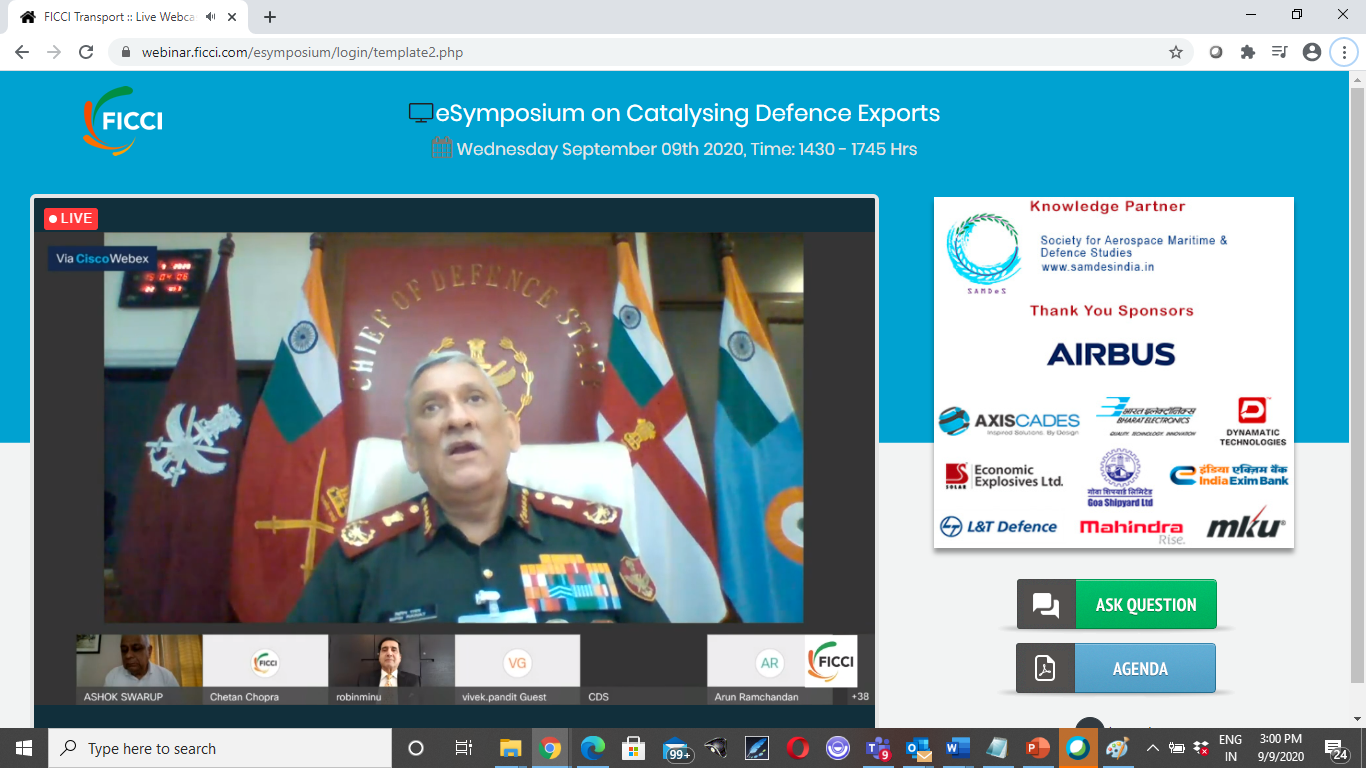The esym on catalyzing defence exports conducted by FICCI with SAMDeS as the Knowledge Partner, featured a galaxy of eminent speakers and about 400 participants. Admiral RK Dhowan, Chairperson SAMDeS, delivered the thematic address emphasizing that Atmanirbhar Bharat and global A&D supply chains were closely linked particularly more so after hon’ble Prime Minister mentioned India’s emerging role as a net security provider in the region in the post pandemic world.
General Bipin Rawat, Chief of Defence Staff, delivered the inaugural address and citing the need for overcoming sanctions in times of conflict stated that the National Defence Industrial Infrastructure must grow to the next higher level so that India does not remain a net importer of defence equipment. He further stated that the defence ministry had issued a draft Defence Production And Export Promotion Policy 2020 and has already introduced a series of measures to chart out the road ahead to increase the local production of defence goods and service to Rs 1,75,000 crore including exports of about Rs 35,000 crore by 2025. He reiterated that the DPSUs/OFBs should be revamped to become important players in the Global Defence Business.
Shri P Harish, Addl Secy (ER) spoke about diplomacy and defence exports and outlined various measures adopted by missions abroad to support defence exports. He recommended that all warship visits to foreign ports showcase Indian technology and also industry associations must avail opportunity to synchronize defence expos during ministerial visits to foreign countries.
Mr Yaduvendra Mathur, Former Spl Secy NITi Aayog and Regional Director (Africa) ISA, spoke about sovereign options for financing defence exports. CMD of HAL, GSL spoke about the potential for helicopter and ship exports whilst BEL spoke about its exports in defence electronics to several countries. Mr Neeraj Gupta, recounted the growth of MKU to become one of the largest global players in Personnel Protection Equipment exporting to several countries. Solar Industries spoke about its capabilities and capacity in explosives manufacturing including R&D which facilitated its transition from industrial to defence explosives making it one of the most modern and largest facility in India. L&T made several recommendations on promoting defence exports including using the LoC mechanism to advantage by creating a corpus of US$10 bn for this purpose, government support for industry including from foreign missions. Mr Saraf, Head of Region – India and South Asia, Airbus Helicopters spoke about the need for an integrated national exo system for promotion of defence exports.
Air Marshal Nambiar said that offsets in defence procurement come at an additional cost of 12-15% and delays the procurement cycle. Hence, offsets may not have served its purpose as various CAG reports have stated. Instead a 5% cess on defence imports could be considered to form a corpus for extending Line of Credit, purchase of ToT, subsidise certain production and prototyping expenses etc. A Defence Export Promotion Council manned by specialised experts is required.
The aspect of quality in defence products, third party certification, raksha guan shakti scheme and opening up the testing infrastructure to all players was discussed by Lt General Sanjay Chauhan, DGQA. He also said that all vendors who had qualified their equipment to DGQA testing would be provided a certificate confirming suitable for military use which could be utilised for exports. He also exhorted Indian industry to become Industry 4.0 compliant to remain competitive in the world market.
Mr Mandal from EXIM bank suggested various options for financing defence exports and assured that EXIM bank would examine such opportunities with objectivity and support. EXIM bank hadd laready prvided US$1.88 bn of Line of Credit across various countries and projects both from the public and private sector. He clearly stated that LoC makes no differentiation between public and private sector companies.
Mr Sanjay Jaju JS, DIP, said that more incentives to strengthen defence exports were underway to reduce time and cost and that US$2 billion was being considered to provide Line of Credit to friendly foreign countries to procure Indian equipment.
Dr RK Tyagi as moderator, brought out that a dedicated pavilion showcasing defence products be set up and the need to converge common facilities into one apex organisation was needed. He also suggested that a time has come to think of a RoE (Russia) type organisation under a JS (Defence Exports).
Commodore Sujeet Samaddar brought out that defence exports is very different from other product and services exports. The marketing of defence exports requires very different capabilities including domain expertise of the concept of operations, doctrinal underpinnings and above all empathy with the potential user. It requires completely new approach to Business Intelligence requiring expertise in geopolitics, international security, arms trade laws, conflict etc so that creation of demand can be anticipated and converted to a business prospect from which leads can be developed by ‘specing in’ Indian products. When a lead is developed, industry must work with both Indian and the foreign government, who is the final buyer, to develop it into an opportunity. Finally, in structuring the contract either as direct commercial or GtG sale, needs a different set of skill sets. Whilst companies manufactring components, parts etc may not such expertise but OEMs building platform and system sales require such processes and the industry must engage with domain experts in promoting exports on the same lines as Foreign OEMs have successfully modelled.
The esym attracted participation form Indian and Foreign Service Chiefs, members of the Civil Services, Diplomats, participants from Public and Private sector industry, bankers, Think Tanks, Media, and University faculty and students. Participation was free to SAMDeS Members.
